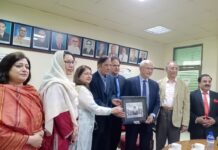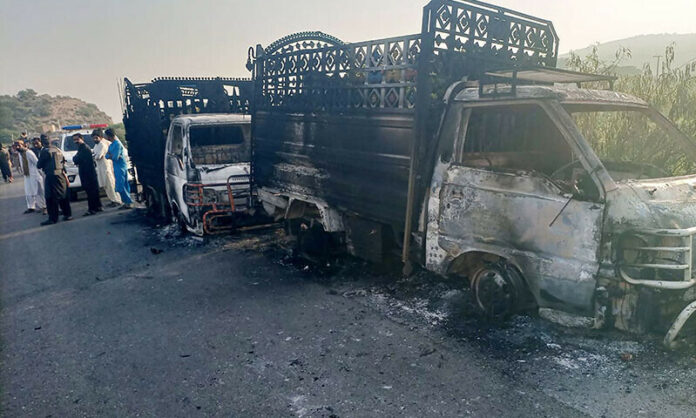AT PENPOINT
The will-they-or-won’t they drama about the PTI’s planned rally for Islamabad could not conceal the fact that its cancellation did not really make that much of a difference to the real purpose of the rally: the release of party chief Imran Khan from jail.
Perhaps the rally’s purpose, which was to develop an atmosphere of uncertainty, was better achieved by two highly dramatic events, which gave the impression that the country was unstable, and the writ of the government did not run. Both events related to Punjab and Balochistan, respectively the most populous and largest provinces. However, while Punjab is a battleground between the PML(N) and the PTI (with the PPP refusing to concede that it has been shut out by this rivalry), Balochistan has a different kind of political structure, and neither of these two parties are really competitive there.
Punjab’s problems with dacoits in the kutcha of the Indus dates back to time immemorial. The badlands along the banks of the Indus, with their thick forests, provide an ideal refuge for anyone in conflict with society, or merely seeking isolation. Hindu rishis no longer inhabit these forests, meditating for years, However, the forests still provide a place of refuge for criminals.
Policing these areas is often a matter of containment rather than eradication. Only in 2013 the authorities conducted an operation against the Chhotu Gang, a huge gang of dacoits. It deployed anti-aircraft guns as well as light and heavy machineguns, all acquired from Afghanistan.
It has just taken a decade for the dacoits to have regrouped. It is to be expected that their old contacts with Afghanistan would be revived, this time across militant strongholds in North and South Waziristan, and across Dera Ismail Khan, all three districts in KP, as well as across Dera Ghazi Khan and Rajanpur, which are Punjab districts. The police maintained a permanent checkpost in the badlands in Rahim Yar Khan district, and it is there that a rocket was fired on a police party returning after completing its period of duty. The resulting 11 policemen killed was not just about the danger of having dacoits at large, but was also about the sectarian terrorists who might have sought refuge there after feeling pressure from the ongoing operation in KP.
The Baloch connection is not just becqause the incident occurred near the Punjab-Balochistan border, but because the dacoits who killed the policemen were ethnic Baloch.
More Baloch, residents of the province and not just because of ethnicity, killed Punjabis, stopping buses and trucks on the highway in Musakhel district in Balochistan, pulling people off and killing them if they identified them as Punjabis. This was clearly Baloch separatism at work, and was met by the Army with the killing of 21 terrorists.
Each incident was perhaps enough to make it clear that Pakistan still suffered from instability, and all the positive developments which had been witnessed since the present government took over, would be overcome. However, both incidents occurring, and with such a small intervening period, showed a country where the government was not in control.
It is worth noting that the incidents occurred in provinces that the PML(N) or its allies in the Centre ruled. The PTI government in KP and the PPP government in Sind remained unaffected. This is even though the KP’s involvement in the Rahim Yar Khan incident, while tangential, cannot be ruled out; and the incident did occur on the Punjab-Sindh border, in an area where there were a large number of ethnic Baloch on both sides of the border.
The government is making all the right noises, and while it is urgently needed to eliminate the militants and separatists as soon as possible, the need to eliminate the causes of disaffection is equally urgent, but likely to involve more thought and patience than some shoot-ém-up operation.
Incidentally, the presence of ethnic Baloch in Punjab and Sindh should provide evidence that Baloch nationalism is not very strong. Indeed, they illustrate some of the divisions among the Baloch. Both Punjabi and Sindhi Baloch are Seraiki speakers, though Punjabi Baloch speak a separate language, though Sindhi Baloch speak Seraiki as a dialect of Sindhi.
One of the divides among the Baloch is linguistic. A large number speak Seraiki, like their Sindhi cousins, while others speak Balochi, an Indo-Iranian language like Pashto or Farsi, while there are also a number of Brahui speakers. Brahui is a Dravidian language, and seems to be a Western outlier of the people who created the Indus Valley Civilization, of which the Mehrgarh Civilization, near the Bolan Pass. was probably the predecessor. The theory is that the Indus Valley peoples were Dravidians, and driven south by Aryan invaders. A remnant remained, and that constitutes today’s Brahui-speaking population.
To add to this linguistic palette, it should be remembered that the Baloch of Dera Ghazi Khan speak a dialect of Seraiki (or a sub-dialec t, if one considers Seraiki a dialect of Punjabi, not a language in its own right) called Balochki, which is influenced by Balochi. Now while the Baloch in both Punjab and Sindh identify as ethnic Baloch, they also are secure about their provincial identity as Punjabi or Sindhi Baloch.
Interestingly, Balochistan is home to a subnational or provincial movement. Balochistan has got a significant and contiguous Pashtun population, actually those provinces of Afghanistan conquered by the Raj in the First Afghan War, and thrown into British Baluchistan, which together with the princely state of Kalat makes up today’s province. There is a small movement for these areas to be separated from Balochistan, not to be merged into KP, but to form a separate province.
By this analogy, it would make a certain sense for the Baloch of Punjab and Sindh to have movements for separation from their provinces, not necessarily for merger into Balochistan, but perhaps as separate movements. However, there are none. It might be remembered that the Irish freedom movement depended on fundraising among the Irish in the USA, and the US involvement in Irish affairs was great enough for it to mediate the 1994 Good Friday agreement that brought about the present arrangement.
It should not be ignored that the Irish since the 1801 Act of Union, were an integral part of the UK, and obtained independence before India. There are several points of convergence. Raj administrators included a disproportionate number of Irishmen, because it was relatively poor, and Irishmen had to seek a living. They applied the experience of managing Irish estates in running Indian districts, and applied the lessons they had learnt from the Great Irish Potato Famine of 1945 to 1852. Ireland became the Irish Free State, much as Azad Jammu and Kashmir became a Free State, with a status still to be settled.
The Baloch on the other hand, have no parallel organisation. That means Baloch separatists have not got the sort of logistical support that the Irish Fenians had, when they engaged in a series of terrorist attacks in London.
Though the outrage committed by the Baloch separatists was horrific, its chances of succeeding seem infinitesimal. There are not enough Punjabis working in Balochistan to cause worries in Punjab. More serious are attacks on pilgrims, something which has been attempted. As Baloch nationalists come together with sectarian militants to slaughter non-Baloch of the ‘wrong’ sect, problems will arise.
The government is making all the right noises, and while it is urgently needed to eliminate the militants and separatists as soon as possible, the need to eliminate the causes of disaffection is equally urgent, but likely to involve more thought and patience than some shoot-ém-up operation.





















